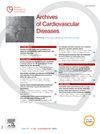Role of cathepsin O variants in intracranial aneurysm formation
IF 2.3
3区 医学
Q2 CARDIAC & CARDIOVASCULAR SYSTEMS
引用次数: 0
Abstract
Introduction
Intracranial aneurysms (IA) are localized dilations of cerebral arteries affecting 3–5% of the global population, with familial forms representing 10% of cases. Rupture of an IA leads to subarachnoid hemorrhage, a condition with a 33% mortality rate and long-term disabilities in half of the survivors. Using whole-exome sequencing, we identified two rare missense variants in the gene encoding cathepsin O (CTSO) (p.Val316Ile and p.Ala43Val) in two large families with multiple affected subjects. CTSO is a cysteine protease, but its physiological role remains undefined.
Objective
The aim of this study is to investigate the expression and function of CTSO in vascular cells to understand how CTSO variants contribute to the predisposition to intracranial aneurysms.
Method
CTSO expression was analyzed by Western blot (WB). CTSO variants (p.Val316Ile, p.Ala43Val) were overexpressed in 3T3 cells. SiRNA knockdown of CTSO was performed in rat aortic vascular smooth muscle cells (VSMCs). Fibronectin expression and localization was analyzed by WB and confocal microscopy. Apoptosis of Human umbilical vein endothelial cells (HUVECs) was assessed by TUNEL and adhesion by impedancemetry (xCelligence) and protein activation (WB).
Results
Western blot analysis revealed that CTSO is expressed and secreted by primary VSMCs, and its secretion was notably enhanced under mechanical stretch. Overexpression of CTSO variants (p.Val316Ile and p.Ala43Val) resulted in reduced secretion of the mutant proteins compared to the WT. In primary VSMCs, we silenced CTSO expression to mimic the loss of secretion induced by CTSO variants and observed an increase of VSMC adhesion, a decrease in VSMC migration, and an accumulation of fibronectin around the cells. To recapitulate the paracrine effect of VSMC-secreted CTSO on endothelial cells, HUVECs were treated with recombinant CTSO (200 ng/mL), which had no effect on adhesion speed or apoptosis but significantly reduced vinculin activation at the Y822 phosphorylation site.
Conclusion
These findings suggest that CTSO may play a key role in regulating endothelial cell-cell junction dynamics. However, further detailed analyses will be necessary to confirm these findings. Additionally, the data indicate that CTSO influences VSMC functions and extracellular matrix composition. The reduced secretion of CTSO variants may disturb these processes, potentially contributing to arterial wall dysfunction.
组织蛋白酶O变异在颅内动脉瘤形成中的作用
颅内动脉瘤(IA)是大脑动脉的局部扩张,影响全球人口的3-5%,家族型占10%。内腔破裂导致蛛网膜下腔出血,死亡率为33%,幸存者中有一半长期残疾。利用全外显子组测序,我们在两个有多个受影响受试者的大家族中发现了编码组织蛋白酶O (CTSO)基因的两个罕见错义变体(p.v ala316ile和p.v ala43val)。CTSO是一种半胱氨酸蛋白酶,但其生理作用尚不清楚。目的研究CTSO在血管细胞中的表达和功能,了解CTSO变异与颅内动脉瘤易感性的关系。方法采用Western blot (WB)检测ctso的表达。CTSO变体(p.Val316Ile, p.Ala43Val)在3T3细胞中过表达。在大鼠主动脉血管平滑肌细胞(VSMCs)中进行CTSO的SiRNA敲除。用WB和共聚焦显微镜分析纤维连接蛋白的表达和定位。采用TUNEL法观察人脐静脉内皮细胞(HUVECs)的凋亡情况,用阻抗法(xCelligence)和蛋白活化法(WB)观察粘附情况。结果western blot分析显示CTSO在原代VSMCs中表达和分泌,在机械拉伸作用下,CTSO的分泌明显增强。与WT相比,CTSO变体(p.Val316Ile和p.a ala43val)的过表达导致突变蛋白的分泌减少。在原发VSMC中,我们沉默CTSO表达以模拟CTSO变体诱导的分泌丧失,并观察到VSMC粘附增加,VSMC迁移减少以及细胞周围纤维连接蛋白的积累。为了总结vsmc分泌的CTSO对内皮细胞的旁分泌作用,重组CTSO (200 ng/mL)处理HUVECs,对粘附速度和凋亡没有影响,但显著降低了Y822磷酸化位点的血管素激活。结论CTSO可能在调节内皮细胞-细胞连接动力学中起关键作用。然而,需要进一步的详细分析来证实这些发现。此外,数据表明CTSO影响VSMC功能和细胞外基质组成。CTSO变异体分泌减少可能干扰这些过程,可能导致动脉壁功能障碍。
本文章由计算机程序翻译,如有差异,请以英文原文为准。
求助全文
约1分钟内获得全文
求助全文
来源期刊

Archives of Cardiovascular Diseases
医学-心血管系统
CiteScore
4.40
自引率
6.70%
发文量
87
审稿时长
34 days
期刊介绍:
The Journal publishes original peer-reviewed clinical and research articles, epidemiological studies, new methodological clinical approaches, review articles and editorials. Topics covered include coronary artery and valve diseases, interventional and pediatric cardiology, cardiovascular surgery, cardiomyopathy and heart failure, arrhythmias and stimulation, cardiovascular imaging, vascular medicine and hypertension, epidemiology and risk factors, and large multicenter studies. Archives of Cardiovascular Diseases also publishes abstracts of papers presented at the annual sessions of the Journées Européennes de la Société Française de Cardiologie and the guidelines edited by the French Society of Cardiology.
 求助内容:
求助内容: 应助结果提醒方式:
应助结果提醒方式:


